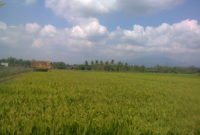This method of irrigation utilizes a system of contour ditches that are laid out over the entire field, and which divide the land into several strips. The water from the head ditch is directed into one ditch at a time and fills the entire ditch. The Major Features of contour ditch irrigation are similar to level basins except for rice. Small dikes or levees constructed on contour. For rice, ponding is maintained. Best for soils with very low intake rate.

The overflow spills over the ditch edge and flood- irrigates the strip of land below. There are no ridges or dikes to restrict the water flow. The water flows across the strip of land to the next contour ditch. Any excess water is collected in the next lower ditch to be used on the next strip. This process is repeated until the entire field is irrigated. The field ditches must be placed closely together to keep the water distribution even throughout the field. The spacing depends on the slope, intake rate of the soil, and the amount of water needed to irrigate each area.
The contour ditch method is often used for close-growing crops in pastures on sloping and rolling land that cannot be easily levelled for other methods of irrigation.
